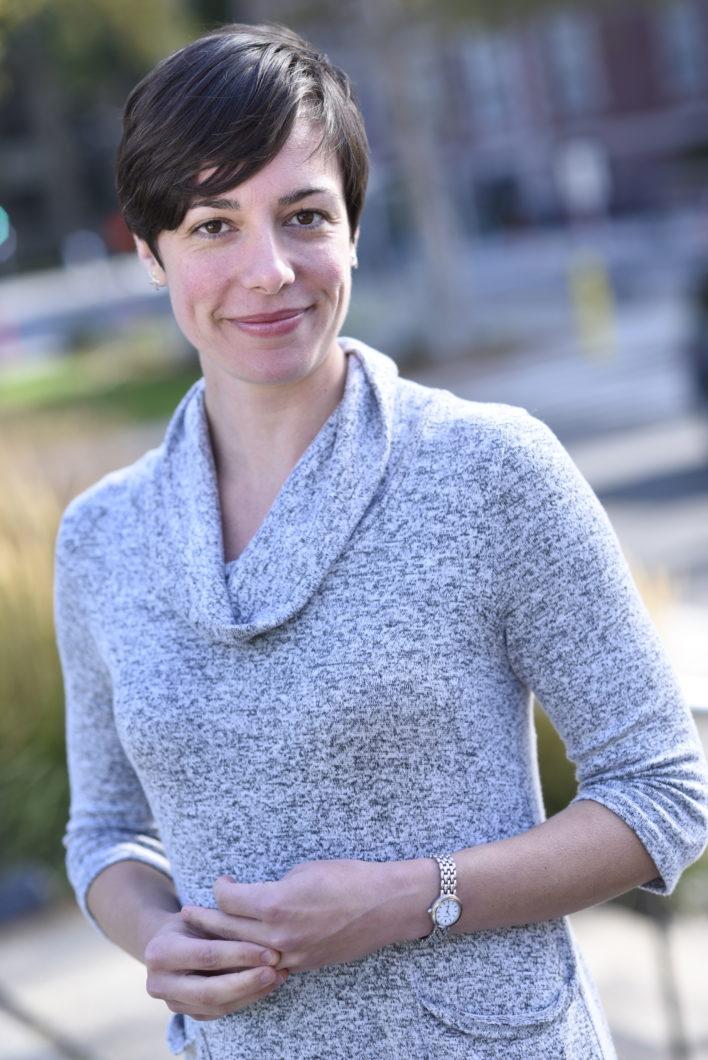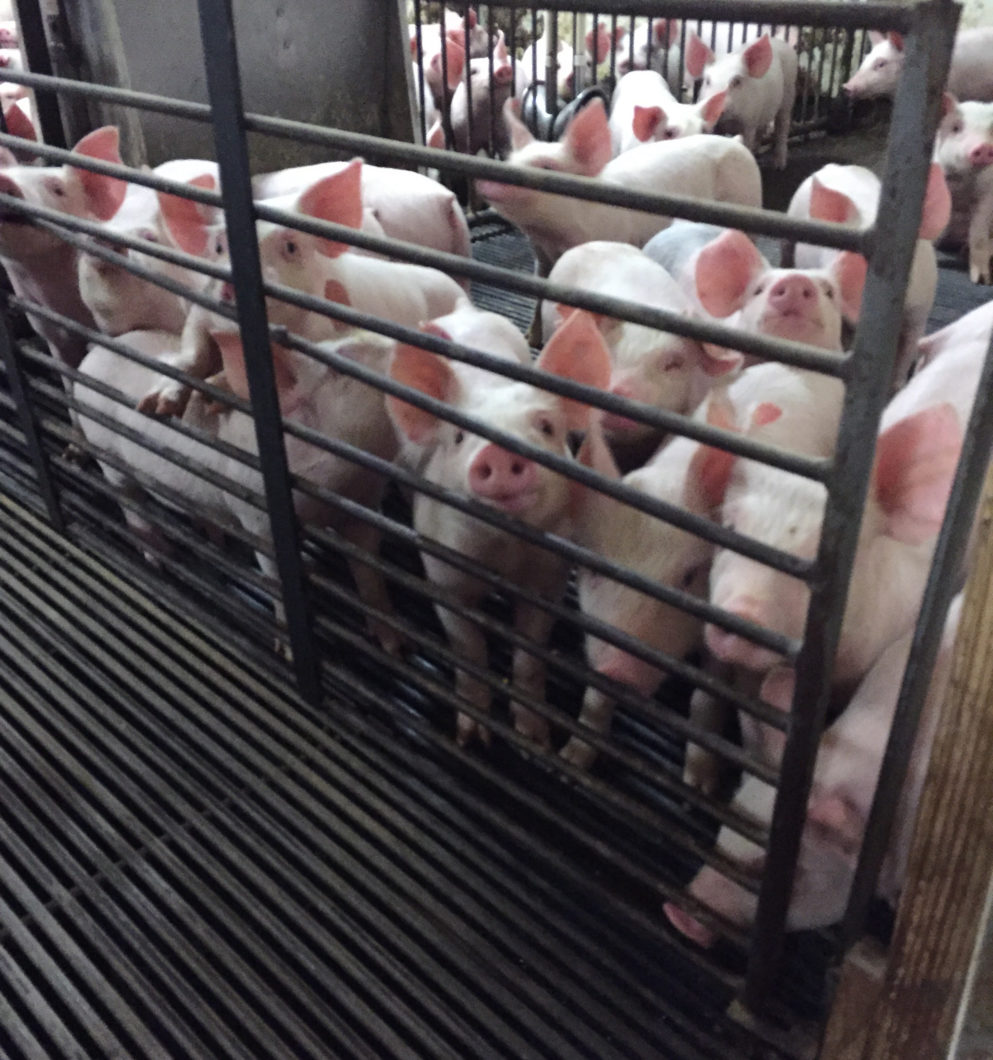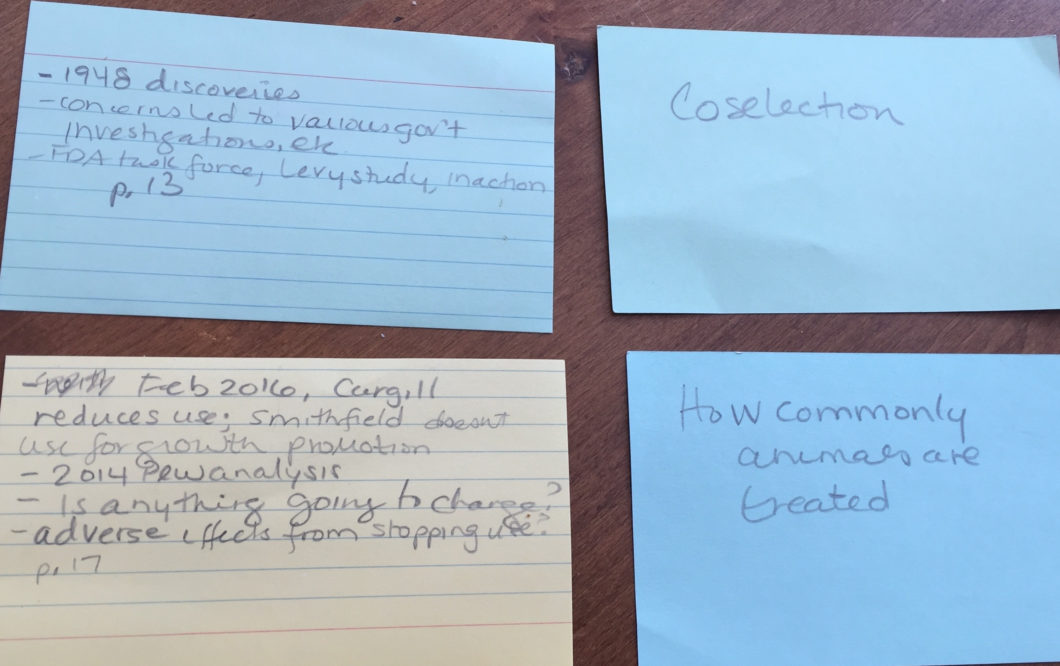
Antibiotic resistance threatens us all. In many states, farmers contract with large corporations to raise tens of thousands of feed animals in close quarters. To prevent diseases from spreading among animals in tight quarters, farmers feed antibiotics preventively. This sets off a chain of events that can create antibiotic-resistant “superbugs.” In her December 2016 Scientific American feature “How Drug-Resistant Bacteria Travel from the Farm to Your Table,” journalist Melinda Wenner Moyer wove together the stories of hog farmers who contract with large companies; the science of antibiotic resistance; the public policies that help perpetuate resistance; and researchers’ efforts to understand how resistance develops on farms, how the problem can spread from farm to table, and how it might spark more drug-resistant infections in people. Although antibiotic resistance in hospitals is a major public health problem, critics are not convinced that the use of antibiotics on farms is driving or worsening the hospital infection problem or causing resistant infections among the public.
Connecting these dots is challenging even for researchers, in part because of industry contracts that prevent scientists from visiting farms. In lieu of site visits, some researchers have resorted to other ways of gaining access to livestock, such as buying pig snouts from butchers and swabbing them for bacteria. Moyer had to find a way to visit these contract farmers—those who are given baby animals owned by a company and also given feed and rules as to how they should raise them. Only the farm and the farming equipment are owned by the farmer.
Moyer’s story was a finalist for a 2017 National Magazine Award and won first place in its category in the 2016 Awards for Excellence in Health Care Reporting by the Association of Health Care Journalists. In addition to contributing regularly to Scientific American and other publications, Moyer writes Slate’s parenting advice column. Here, this resident of New York’s Hudson Valley tells TON editor-at-large Jeanne Erdmann how she tromped through pig sludge on midwestern farms, navigating complicated science and public policy along the way. (This interview has been edited for length and clarity.)
Did you propose this story? Is it a topic you’d been following?
I did not pitch this. I got a four-sentence email from [Scientific American senior editor] Josh Fischman, the editor I work with now. The subject line was, “Antibiotics in Animals? A Story Idea??” The email basically said that the editors wanted a science story about antibiotic resistance, how using antibiotics in animals contributes to drug-resistant microbes in humans, and efforts to reduce their use.
I have been writing for Sci Am for years, but I hadn’t done a print feature in quite a while. I initially interpreted the email as a request for an online feature of about 1,500 words, and it’s such a big topic. I wrote back and said I don’t know if I’m the best person, and I named some other writers. I can’t believe that I said this. Josh wrote back and said something like, “I don’t know if I made myself clear. We want you to take five months to do a print story. We want to send you to farms. We really want to dig into this, and we want you to do it.”
I was really flattered and surprised and immediately said, “Yes, that sounds fun.”
What was your process for thinking about how you’d frame this story and what angle to focus on?
We didn’t have the angle figured right away. At Sci Am, you have to submit a proposal and get it formally accepted by the editorial board. I spent about a month on and off, and turned in a couple of pages detailing how I was going to report the issue, how I’d connect the dots between what we know about how antibiotic use on farms contributes to antibiotic resistance in people; why we don’t know more; why isn’t the government doing more; and what the veterinary pharmaceutical industry is doing, if anything, to resist attempts to get farmers to reduce antibiotic use.
The proposal was approved in March 2016. Then, I thought, “How do I dig into this?” Josh wanted me to visit farms and to learn why—if we’ve known about this resistance for a while—things haven’t changed, and whether we are certain the agricultural use of antibiotics is causing problems. But pretty early on, in some of my first interviews, sources told me that they suspected it was going to be hard for me to get access to farms.

Once you realized that getting to see farms was going to be difficult, how did you manage access?
That took a long time to set up. One of the first things I did was contact nonprofits that work with farmers—Food and Water Watch and RAFI [Rural Advancement Foundation International]—and asked if they knew any farmers who might be willing to talk to me and let me come onto farms. I also asked them to help identify scientists working in this area. I knew that advocacy organizations would give me one perspective—their perspective—but I wanted to start gathering thoughts from people in the field.
At the same time, I started downloading review papers on antibiotic resistance and farm use of antibiotics, both for background and to find more scientists to interview. I was very lucky because I told one of the researchers at an agricultural school, who also worked with the National Pork Board, that I was hoping to visit a farm, and he reach out to them on my behalf.
How did you choose hogs over other animals raised for food?
I collected opinions from everybody I talked to. I asked them to identify the biggest problems in the industry and which animals are raised with the most antibiotics. I knew that there was a lot of coverage of the poultry industry already, including industry improvements and positive stuff happening. I thought pigs would work because it’s hard to raise hogs without antibiotics, and Americans eat a lot of pork. I also got an email from the National Pork Board saying they’d let me onto some farms.
Once you started reporting and visiting farms, how did the characters for your narrative emerge?
It was not obvious. I thought maybe a farmer, but this is not about farmers. I realized that it’s kind of about the animals and the bacteria themselves, so I had this zany idea of making bacteria the characters in my story, and tracking the hypothetical bacteria from a single pig through the environment. Pretty early on, I realized that I hadn’t read a clear explanation of how bacteria get from farm animals to people in hospitals dying of resistant infections, and, if they do, by which steps.
How and when did you decide to put yourself into the story?
I really don’t like putting myself in stories. When I visited the pig farms, I was hoping to have some kind of eureka moment, or a memorable moment with an animal, and then maybe use that animal or the bacteria inside it as the jumping-off point in my narrative. As I walked through these farms, I realized that the problem with focusing on bacteria is you can’t see them, you can’t really picture them, but you can picture how they interact with a person walking around a farm. I was getting manure on my shoes, on me, and on my hands—experiences that brought the bacteria to life in some weird way.
On one farm, a pig hit me in the butt with his nose, and I thought, “Maybe this is the pig.” Then I realized that if it was nudging me then I was in the story. And I thought, “Well, maybe it does make sense for me to be in the story,” and I could have this be a story of my discovery of the problem, my investigation of this problem; and other characters will be this pig that nudged me, and the bacteria.

Did you worry that the farmers would suffer any negative consequences for talking so openly? How did you handle the diplomacy around that?
The horror stories I’d heard about farmers experiencing retaliation were mostly [about] contract farmers, and I did worry. I talked to Josh a little bit about it.
Noncontract farmers such as [Keith] Schoettmer [of Schoettmer Prime Pork in Tipton, Indiana] usually still have contracts with companies, but they are selling their own animals to a particular company—so the farmer has some freedom in terms of what he feeds the animals and how he takes care of them, and he may have running contracts with more than one company.
I did worry about Mike Beard [in Frankfort, Indiana] because he was a contract farmer. I did some more research on Beard and realized he’s somebody that the National Pork Board goes to frequently for tour requests. I found a profile of him in a farming magazine saying he’s hosted people who are both anti-industrial and pro-industrial farming. I was less worried about him after that. I was aware too, that because the National Pork Board was picking the farms I was going to see, that I was going to see the best of the best.
I didn’t know how else to get onto these farms or how much pressure there is not to let people like me on the farms. That was just something I had to deal with. Even so, these farms are still using antibiotics, and they were very open about their use. I felt like I was still able to use what I learned on those farms.
You mentioned sources who declined to participate (the American Farm Bureau Federation; Smithfield Farms). Were there a lot of organizations who did so?
Most of the pork companies did not want to talk to me, including Hormel, Tyson, and Smithfield. They either didn’t respond, or would say, “Oh, we’ll try to help,” and then disappear. The American Farm Bureau as well didn’t respond; I contacted them four to six times, and I never got a reply.

What were some of your biggest obstacles in reporting, and how did you overcome them?
I kept hearing from these sources over and over again, “We can’t definitively prove much, because we can’t get onto farms.” It dawned on me that these scientists aren’t able to answer the questions that they really want to answer, and this was an important part of the story, too. After I’d been on farms in Indiana, I went back to some of the farm organizations, like RAFI, and they connected me with some people who said it was in their contracts that they are not supposed to let people on the farms and they would be punished if they did. I [also] talked to the FDA, and they told me that industry pressure was responsible for them backing down from tougher legislation. It became clear there was this scheme that industry was making it hard for scientists and for the government to make any progress, and that was going to be an important part of the story, too.
It can be risky for freelancers to take on investigative stories. Did you take any special steps to protect yourself from legal problems or from online harassment?
I did not with this story, but since this came out I’ve thought about what I can do to protect myself and my family more. I’ve slowly been ticking them off, such as getting Twitter verified, and locking down what people can see on Facebook who are not my friends, and what information about me is on the Internet—which is hard to do, but I’ve removed myself from some sites. I joined the Author’s Guild; they have a free service in which lawyers will look at contracts. I sent a contract for another investigative piece to them, and, within two days, they wrote back and identified problematic language. Now that I am working on another piece for Sci Am that is even more controversial, I realized I need to lock things down and protect myself.
How did the editing process go on the antibiotics story?
Josh is fantastic. He’s really easygoing and has this calming demeanor, which is really great for me because I’m kind of an uptight reporter. I’m anxious, and I want things to be right and he’s very laid back. He’s conscientious, but he’s like, don’t stress, it’s going to work out.
How did the story change in editing?
The structure stayed the same, but Josh wanted three or four new studies in the lede, about why the problem is becoming more and more important. I understood that need, but I treated the story as a deep dive into this issue, and why we haven’t solved it. I’d conceived of it as less newsy. That was hard to balance. I think putting the news and the references to the recent studies in made it much better. Most of the color stuff stayed in, which made me really happy.
You chose to end your story with a nice summing up rather than a quote. How did you choose to do so?
I wanted to try to keep the ending simple and drive home two key points: that there isn’t nearly enough good data and research to tell us exactly how worried we should be about farm-driven antibiotic resistance; yet that even so, the data we have suggests that we should be concerned and making changes. In other words, we may not know everything, but we know enough to have clarity on the need to take action.
Are there any lessons that you learned in reporting and writing this piece?
I have been notoriously bad in the past about trying to finish up my reporting and then writing up everything in about five days. For this piece, I started writing with five days left to my deadline, and then Josh gave me three more weeks. I spent the rest of the time writing and filling in gaps in reporting. It was amazing to have that much time; I am going to do that from now on. It may not have been a good use of my time in a way, but if I needed to spend an afternoon on two paragraphs, I did that. I lost a lot of money, but it made the piece better, and it made the writing less stressful.
As I am taking on more investigative pieces, I have to find a way to make it work financially. I’m turning down other assignments because I don’t have the headspace or time to take on as much, and my salary is dropping. I loved writing this piece, and Sci Am pays me well, but I spent so much time on it, and I need to figure out how to make that work. I don’t know if there’s a good solution for stories that are really rewarding in every other way but financially. But this was definitely one of the more rewarding pieces I’ve worked on.

TON cofounder and editor-at-large Jeanne Erdmann is an award-winning freelance health-and-science writer based in Missouri. Her writing has been published in Nature Medicine, Nature, Women’s Health, Discover, The Washington Post, Slate, Aeon, and elsewhere. She is on the board of the Association of Health Care Journalists. Follow her on Twitter @jeanne_erdmann.


